Larissa
| Larissa Λάρισα |
|
|---|---|
 |
|
| Location | |
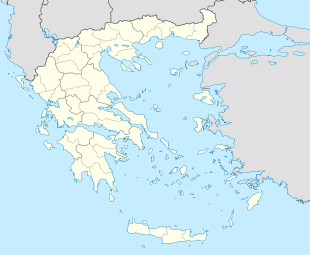 Larissa
|
|
| Coordinates | |
|
Location within the prefecture
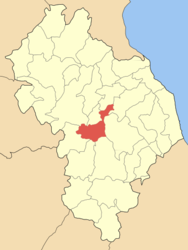 |
|
| Government | |
| Country: | Greece |
| Periphery: | Thessaly |
| Prefecture: | Larissa |
| Districts: | 31 |
| Population statistics (as of 2001[1]) | |
| City | |
| - Population: | 126,076 |
| - Area: | 122.586 km2 (47 sq mi) |
| - Density: | 1,028 /km2 (2,664 /sq mi) |
| Other | |
| Time zone: | EET/EEST (UTC+2/3) |
| Elevation (center): | 67 m (220 ft) |
| Postal: | 41x xx |
| Telephone: | 2410 |
| Auto: | ΡΙ |
| Website | |
| www.larissa-dimos.gr | |
Larissa (Greek: Λάρισα, [ˈlarisa]) is a city and the capital of the Thessaly periphery of Greece, and capital of the Larissa Prefecture. It is a principal agricultural centre and a national transportation hub, linked by road and rail with the port of Volos and with Thessaloniki and Athens. The population of the greater area is around 250,000, and takes in of Nikaia, Giannouli and other smaller suburban communities. According to archaeological evidence, the capital of Thessaly, Larissa, lies atop a site that has been inhabited since the tenth millennium BCE. A major commercial and industrial centre. Legend has it that Achilles was born here and Hippocrates, the Father of Medicine, died here
Contents |
Geography
There are a number of highways including E75 and the main railway from Athens to Thessaloniki (Salonika) crossing through Thessaly. The region is directly linked to the rest of Europe through the International Airport of Central Greece located in Nea Anchialos a short distance from Larissa.
Larissa lies on the river Pineios.
The Larissa Chasma, a deep gash in the surface of Dione, a natural satellite of Saturn, was named after Larissa.
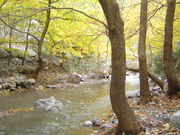
Mythology
The city is said in Greek mythology to have been founded by Acrisius, who was killed accidentally by his son, Perseus[2]. There lived Peleus, the hero beloved by the gods, and his son Achilles; however, the city is not mentioned by Homer, unless it should be identified with Argissa of the Iliad[3].
In mythology, the nymph Larissa was a daughter of the primordial man Pelasgus.[4]
History
Antiquity

Traces of Paleolithic human settlement have been recovered from the area, but it was peripheral to areas of advanced culture.[5] The area around Larissa was extremely fruitful; it was agriculturally important and in antiquity was known for its horses.
The name Larissa,[6] inherited from the Pelasgian settlers— an alternative name for the district was Pelasgiotis— was common to many Pelasgian towns: the ancient Greek word larissa means "stronghold".[7]
Larissa is thought to be where the famous Greek physician Hippocrates and the famous philosopher Gorgias of Leontini died.
When Larissa ceased minting the federal coins it shared with other Thessalian towns and adopted its own coinage in the late fifth century BC, it chose local types for its coins. The obverse depicted the nymph of the local spring, Larissa, for whom the town was named; probably the choice was inspired by the famous coins of Kimon depicting the Syracusan nymph Arethusa. The reverse depicted a horse in various poses. The horse was an appropriate symbol of Thessaly, a land of plains, which was well-known for its horses. Usually there is a male figure; he should perhaps be seen as the eponymous hero of the Thessalians, Thessalos, who is probably also to be identified on many of the earlier, federal coins of Thessaly.
Larissa, sometimes written Larisa on ancient coins and inscriptions, is near the site of the Homeric Argissa. It appears in early times, when Thessaly was mainly governed by a few aristocratic families, as an important city under the rule of the Aleuadae, whose authority extended over the whole district of Pelasgiotis. This powerful family possessed for many generations before 369 BC the privilege of furnishing the tagus, the local term for the strategos of the combined Thessalian forces. The principal rivals of the Aleuadae were the Scopadac of Crannon, the remains of which are about 14 miles south west.
Larissa was indeed the birthplace of Meno, who thus became, along with Xenophon and a few others, one of the generals leading several thousands Greeks from various places, in the ill-fated expedition of 401 (retold in Xenophon's Anabasis) meant to help Cyrus the Younger, son of Darius II, king of Persia, overthrow his elder brother Artaxerxes II and take over the throne of Persia (Meno is featured in Plato's dialogue bearing his name, in which Socrates uses the example of "the way to Larissa" to help explain Meno the difference between true opinion and science (Meno, 97a–c) ; this "way to Larissa" might well be on the part of Socrates an attempt to call to Meno's mind a "way home", understood as the way toward one's true and "eternal" home reached only at death, that each man is supposed to seek in his life).[8]
The constitution of the town was democratic, which explains why it sided with Athens in the Peloponnesian War. In the neighbourhood of Larissa was celebrated a festival which recalled the Roman Saturnalia, and at which the slaves were waited on by their masters. It was taken by the Thebans and afterwards by the Macedonian kings, and Demetrius Poliorcestes gained possession of it for a time, 302 BC.
Hellenistic and Roman era
It was in Larissa that Philip V of Macedonia signed in 197 BC a treaty with the Romans after his defeat at Cynoscephalae, and it was there also that Antiochus III, the Great, won a great victory, 192 BC.
As the chief city of ancient Thessaly, Larissa was directly annexed by Philip II of Macedon in 344, and from then on Larissa was under Macedonian control; in 196 B.C. Larissa became an ally of Rome and was the headquarters of the Thessalian League.
Larissa is frequently mentioned in connection with the Roman civil wars which preceded the establishment of the empire and Pompey sought refuge there after the defeat of Pharsalus.
Middle Ages and Ottoman period
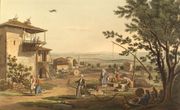
The town was taken from the Byzantine Empire by Bulgaria for a while in the later 10th century and later held by Serbia. It was Frankish until 1400.
In the 15th century, it came under the rule of the Ottoman Empire, who called it Yenişehr-i Fenar 'new town of the Phanariots'. Until 1881, Larissa was the seat of a pasha in the vilayet of Yanya. On 6 March 1770, Aya Pasha massacred there 3000 Christians from Trikala.
In the 19th century, there was a small village in the outskirts of town very unusually inhabited by Africans from the Sudan, a curious remnant of the forces collected by Ali Pasha. In the 19th century, the town produced leather, cotton, silk and tobacco. Fevers and agues were prevalent owing to bad drainage and the overflowing of the river; and the death-rate was higher than the birth rate. It was also renowned for the minarets of its mosques (four of which were still in use in the early part of the 20th century) and the Muslim burial grounds.
Modern Greek era
Larissa was the headquarters of Hursid Pasha during the Greek War of Independence. In 1881, the city, along with the rest of Thessaly, was incorporated into the Kingdom of Greece. A considerable portion of the Turkish population emigrated into the Ottoman Empire at that point. During the Greco-Turkish War of 1897, the city was the headquarters of Greek Crown Prince Constantine. The flight of the Greek army from here to Farsala took place on April 23, 1897. Turkish troops entered the city two days later. After a treaty for peace was signed, they withdrew and Larissa remained permanently in Greece. This was followed by a further exodus of Turks in 1898.
Ecclesiastical history
Christianity penetrated early to Larissa, though its first bishop is recorded only in 325 at the Council of Nicaea. St. Achillius of the fourth century, is celebrated for his miracles. Lequien[9] cites twenty-nine bishops from the fourth to the eighteenth centuries; the most famous is Jermias II, who occupied the Patriarch of the West until 733, when the Emperor Leo III the Isaurian annexed it to the Patriarchate of Constantinople. In the first years of the tenth century it had ten suffragan sees[10]; subsequently the number increased and about the year 1175 under the Emperor Manuel I Comnenus, it reached twenty-eight[11]. At the close of the fifteenth century, under the Turkish domination, there were only ten suffragan sees[12], which gradually grew less and finally disappeared.
Larissa remains a titular see of the Roman Catholic Church.
Historical population

- 1889: 13,610 (city)
- 1907: 18,001 (city)
- 1907: 95,066 (prefecture)
- 1991: 113,781 (city)
- 1991: 277,973 (prefecture)
- 2001: 126,076 (city)
- 2001: 279,305 (prefecture)
Archaeological sites
- Ancient Theatre A'
- Ancient Theatre B'
- Fortress Hill & Ancient Agora
Museums
- Municipal Gallery-G.I. Katsigras Museum
- Historical & Folklore Museum
- Archaeological Museum of Larissa
- Veterinary Military Museum
- Folklore Society of Larissa
Districts
The Municipality of Larissa is divided into two Municipal Districts (Larissa and Terpsithea). The Municipal District of Larissa is subdivided into four city-districts (31 city areas) and two suburban districts (Amphithea and Koulourion). The Municipal District of Terpsithea is subdivided into two suburban districts (Terpsithea and Argyssa).
- Saint Achellios
- Saint Nikolaos
- Saint Athanasios
- Alkazar
- Hippocrates
- Papastavrou
- Ambelokipoi
- Saints Saranta
- Lachanokipoi
- Nea Smyrne-Kamynia
- Kalyvia-Saint Marina
- Charavgi
- Toumba-OKE
- Pyrovolika-Pharos
- Averof-Sekfo
- Nea Politia
- Saint Georgios
- Pinioupolis
- Philippoupolis
- Livadaki
- Epirotika
- Neapolis
- Saint Konstantinos
- Stathmos
- Anthoupolis
- Saint Thomas
- Saint Paraskevi-Mezourlo
- Neraida
- Anatoli
- Kampos
- Potamoupolis
Transport
Larissa sits in the middle of the plain of Thessaly, with connections to national roads GR-1 (Athens-Thessaloniki), GR-3 (Elefsina-Florina) and GR-6 (Igoumenitsa-Volos).
- Larissa's Urban Bus System
- Larissa's Interurban System
- Larissa Central Railway Station at
- Mezourlo Freight Railway station at
- Larissa Airport
- Larissa Tram (planned)
Sports

Two football teams are based in Larissa. Larissa F.C. currently play in Super League Greece. They were Greek Champions in 1988 and Cup Winners in 1985 & 2007. They are the only team from outside Athens or Thessaloniki to have won the Greek League. Fourth Division club Apollonas Larissa also play in the town.
- Gymnastikos Olympia (A1 Ethniki) Basketball team
- Alkazar Sport Complex
- Alkazar Arena Stadium / AEL Arena [1]
- Alkazar National Stadium
- Municipal Swimming Pool
- Equestrian Club of Larissa
- Neapolis Palais de Sports
- Larissa's Nautical Club
- Alkazar Golf Center
- The Ice Skating Rink
Notable people
Ancient
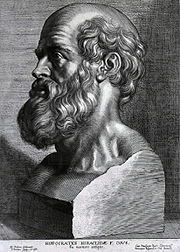
- Achillius of Larissa (270–330), saint
- Hippokrates of Kos (460 BC–370 BC), physician, died in Larissa
- Larissa, mythological nymph from Thessaly
- Medius (4th century BC), friend of Alexander the Great
- Philinna (4th century BC), dancer, mother of Philip III Arrhidaeus
- Philo (1st century BC), philosopher
Modern
- Paraskevas Boubourakas (1972-) fashion model
- Konstantinos Chalkias (1974-) footballer
- Dimosthenis Dikoudis (1977-) basketball player
- Petros Efthimiou (1950-) politician
- Theofanis Gekas (1980-) footballer
- Alexis Georgoulis (1974-) actor
- Yannis Goumas (1975-) footballer
- Kostas Gousgounis (1931-) porn actor
- Fani Halkia (1979-) hurdler
- M. Karagatsis (1908–1960) novelist, journalist
- Vassilis Karapialis (1965-) footballer
- Nestoras Kommatos (1977-) basketball player
- Dimitris P. Kraniotis (1966-) poet & medical doctor
- Lakis Lazopoulos actor, comedian, script author & director
- Georgios Mitsibonas (1962–1997) footballer
- Vaggelis Moras (1981-) footballer
- Giorgakis Olympios (1772–1821) armatolos
- George Seremetis (1879–1950) lawyer, mayor of Thessaloniki
- Sotiris Skipis (1881–1952) poet
- Georgios Souflias (1941-) politician
- Dimitris Spanoulis (1979-) basketball player
- Vassilis Spanoulis (1982-) basketball player
- Athena Tacha (1936-) artist
- Takis Tloupas (1920–2003) photographer
- Achilleas Tzartzanos (1873–1946) linguist, philologist
- Anna Vagena actress
- Ekaterini Voggoli (1970-) discus thrower
- Antonis Vratsanos (1919–2008) awarded "Senior Commander of the Order of Honor" for his action of resistance against foreign occupation troops in the years 1941-44
- Eleni Zafeiriou (1916–2004), actress
Twin Towns — Sister Cities
Larissa is twinned with:
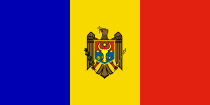 Bălţi in Moldova
Bălţi in Moldova Banská Bystrica in Slovakia
Banská Bystrica in Slovakia Knoxville, Tennessee in United States
Knoxville, Tennessee in United States Stara Zagora in Bulgaria
Stara Zagora in Bulgaria Rybnik in Poland, since 13 June 2003[13]
Rybnik in Poland, since 13 June 2003[13]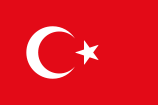 Ürgüp in Turkey
Ürgüp in Turkey
See also
- CERETETH, Center of Technology Thessaly
- 2013 Mediterranean Games Larissa-Volos
Notes
- ↑ "Δείτε τη Διοικητική Διαίρεση" (in Greek). Hellenic Interior Ministry. www.ypes.gr. http://www.ypes.gr/UserFiles/f0ff9297-f516-40ff-a70e-eca84e2ec9b9/D_diairesi.xls. Retrieved 2009-09-09.
- ↑ Stephanus Byzantius, s.v.
- ↑ II, 738.
- ↑ Pausanias, 2.24.1
- ↑ Curtis Runnels and Tjeerd H. van Andel. "The Lower and Middle Paleolithic of Thessaly, Greece" Journal of Field Archaeology 20.3 (Autumn 1993:299–317) summarises the survey carried out in June 1991.
- ↑ "The city and the plain around it were settled in prehistoric times, and its name must be early, but it is first mentioned in connection with the aristocratic Aleuadai, whose home it was." (Richard Stillwell, William L. MacDonald, Marian Holland McAllister, eds., The Princeton Encyclopedia of Classical Sites (Princeton University Press) 1976, 's.v. "Larissa, or Larisa, or Pelasgis, Thessaly").
- ↑ "Henry George Liddell, Robert Scott, A Greek-English Lexicon". Perseus.tufts.edu. http://www.perseus.tufts.edu/cgi-bin/ptext?doc=Perseus%3Atext%3A1999.04.0057%3Aentry%3D%2361971. Retrieved 2009-07-08.
- ↑ Cities and Locations of Ancient Greece. Larissa
- ↑ Oriens Christianus II, 103-112.
- ↑ Heinrich Gelzer, "Ungedruckte. . .Texte der Notitiae episcopatuum", Munich, 1900, 557.
- ↑ Parthey, Hieroclis Synecdemus, Berlin, 1866, 120.
- ↑ Gelzer, op. cit., 635.
- ↑ "Rybnik Official Website — Twin Towns". City of Rybnik. Urząd Miasta Rybnika, ul. Bolesława Chrobrego 2, 44-200 Rybnik. http://www.rybnik.pl/index.php?id=324. Retrieved 2008-11-01.
External links
- Larissa; 1911 Encyclopædia article.
- Source
- Official Website
- Region of Thessaly Official Website
- International airport of Central Greece
|
||||||||
|
|||||
|
|||||